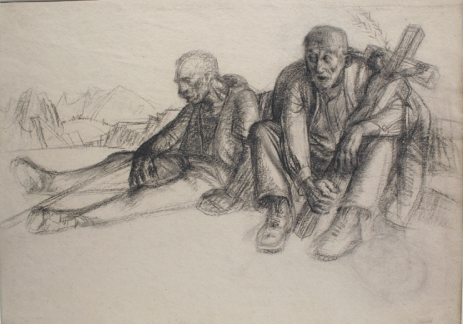Still in the Blackheath area, we now come to James Woodford (1893 - 1976). Not someone who was known for his prints, the first two images you see here are the actual boxwood blocks he made, both of them well in line with the kind of wood-engravings the sculptor and printmaker Eric Gill was producing in the 1920s. I don't whether there were editions or even whether he sold any but he must have made proofs. But this post isn't so much about his printmaking as the play-off between the different media he used - drawing, engraving, modelling and relief sculpture.
Like me, he was brought up in Nottingham, the son of a lace designer. After studies at the local school of art, interrupted by war-time service, he went on to the RCA in London (where he might have got to know Charles Paine). 1922 saw him with a three-year scholarship to study sculpture at the British School in Rome. You can see him below two years later in this wonderful study by Robert Austin - Woodfood posed for the figure on the right - where the large crucifix brings in the requisite Catholic note. (Eric Gill, whose work he must have known, was a convert).
It's certainly interesting to note the unnerving mix of religion and eroticism for which poor Gill has become so notorious. Obviously it's quite hard to judge their effectiveness as prints when all we see is the block. The real print you see below, I think is ungainly. The interests of the sculptor in form and carving are uppermost. What matters, though, is the effort he put into producing work that would be flat.
You only have to compare Austin's subtle draughtsmanship with Woodford's stark, anatomical description of this cow, to see just how different their priorties were. Even so, I think it was his approach to modelling and structure that had an impact on his colleagues. Because by about 1930 Woodford was at Blackheath school of art, alongside Charles Paine and John Platt. (All three men were certainly there some time between 1932 and 1935).
This bronze relief for a series at Norwich City Hall especially reminds me of the woodcut of a bull that Platt produced in March, 1932. The position of the animal is almost exactly the same. I have no way of knowing exactly what interaction existed between staff and students at the school. Norwich City Hall was opened in 1938 but Woodford must have been working on his panels well before that. All I want to suggest is the way these artists and teachers were open to new ways of doing things. Both Platt and Paine changed their style in the 1930s. I don't think this is just something you dream up on your own or on a whim. You only need to scroll back to Paine's Welwyn squirrel to see the way he analyses structure in a new and envigorating way. Woodford's bull may well be a compliment to his friend, John Platt. Platt mentions both men as friends in his Authors' Note to Colour Woodcuts of 1937. We are not talking about up-and-coming artists here; these were all succesful men. It was in 1937 that Woodford was elected associate of the Royal Academy. You can see him seated third from the left with the-great-and-the-not-so-good of the selection committee. Woodford, Platt and Paine may not have been modernists but all of them, to their credit, were affected by the modern spirit - and made it new. [I must add here that I am grateful to Liss Fine Art for all the images here apart from the RA photo, the Austin, which is Abbot & Holder's, and the bronze relief.]








those top ones, and the one of mother and child are VERY like eric gill. who preceeded whom? i couldn't tell from the post. i should tell you my eric gill story some time.
ReplyDeleteWoodford made so few woodblocks, I assume he was following Gill (who was 10 years older). Anyway, we don't have dates for the Woodford prints, so who knows?
ReplyDelete